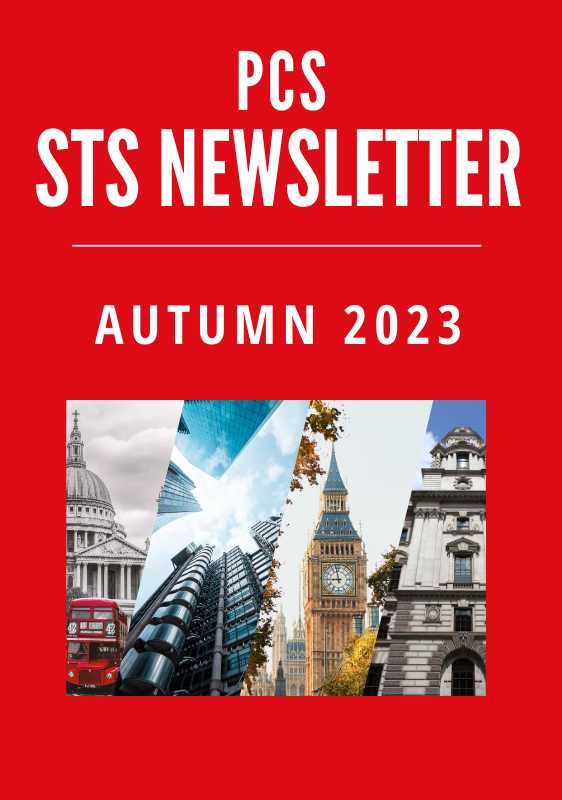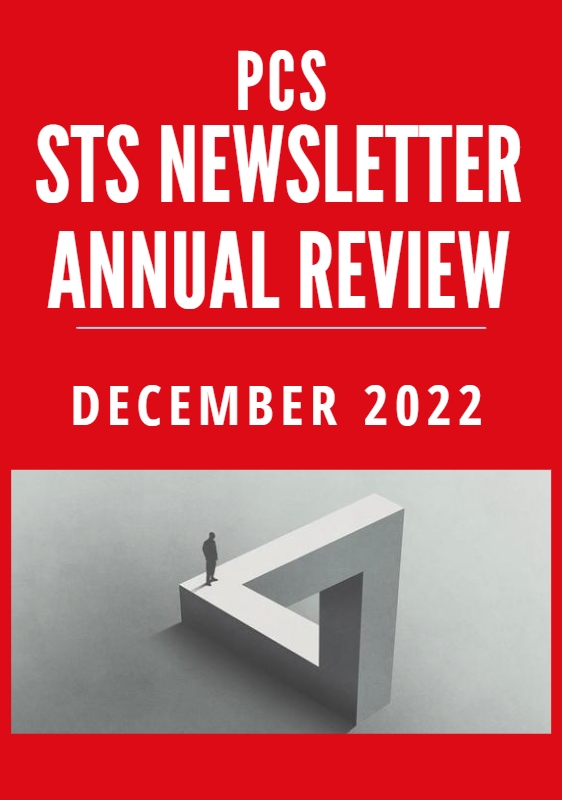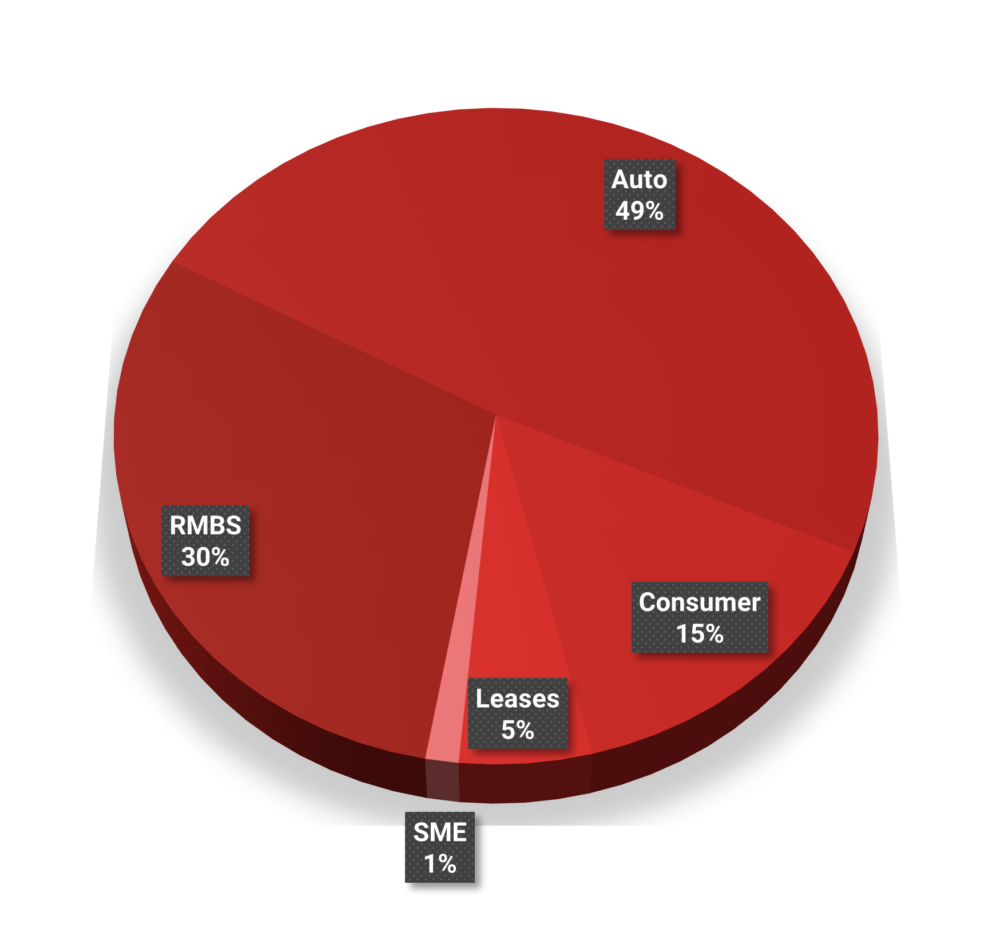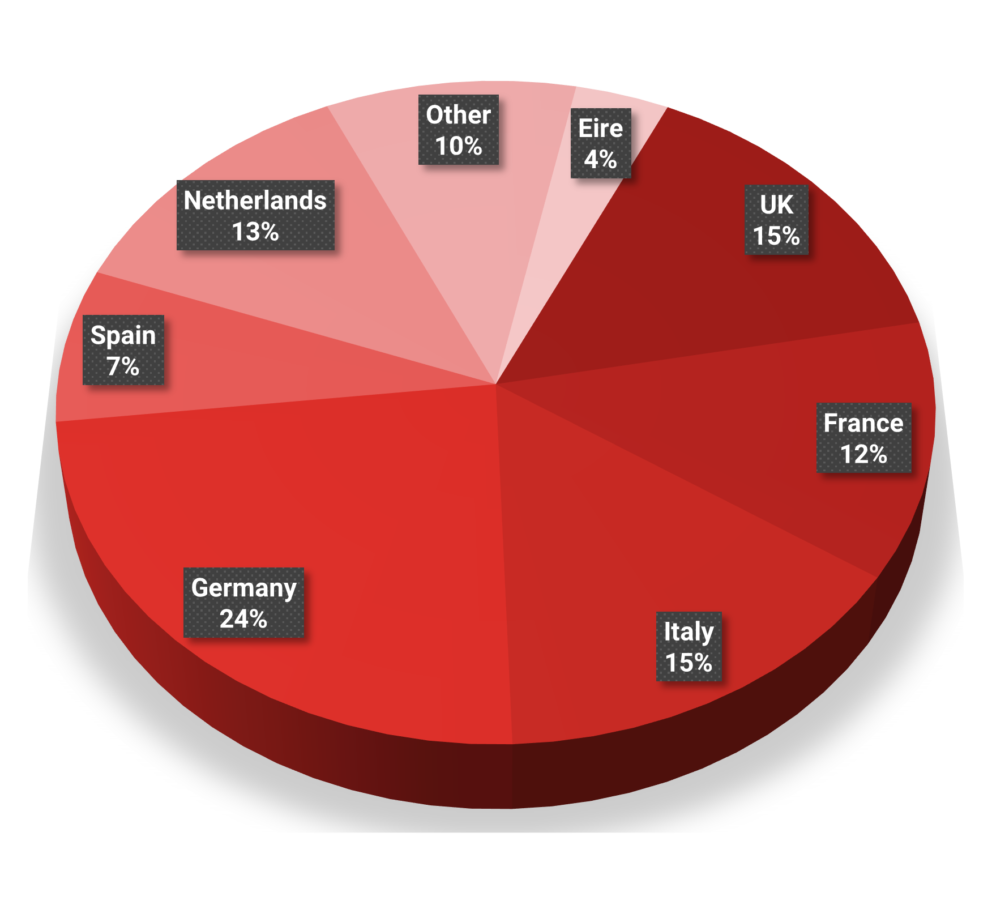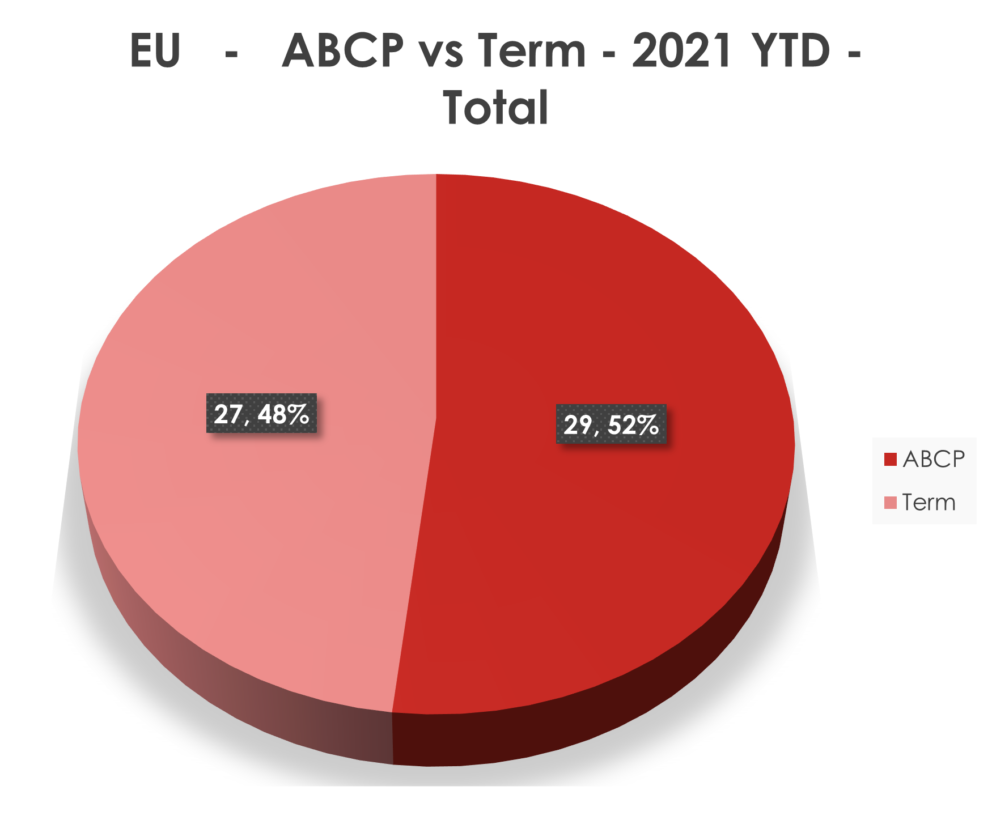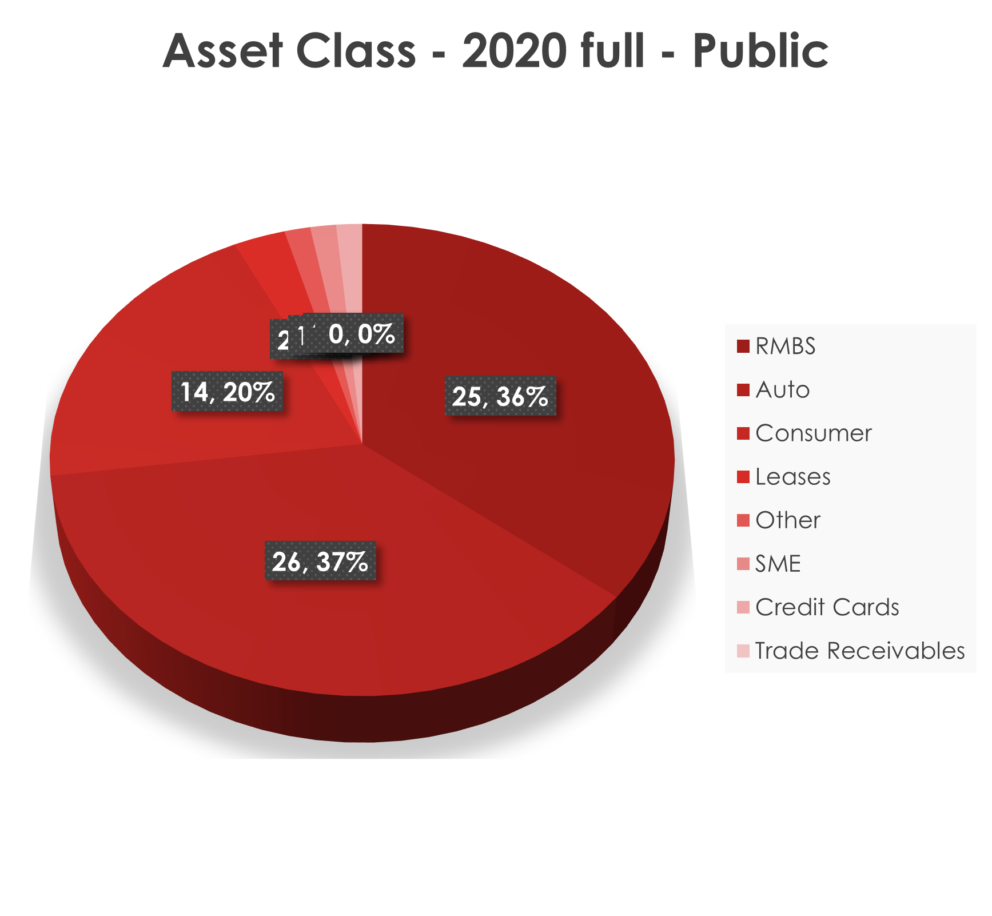June 2024 Newsletter

Welcome!
Welcome to the pre-Barcelona STS Newsletter by PCS, keeping stakeholders up to date about market and regulatory developments in the world of STS.
As ever, we very much welcome any feedback on this newsletter.
Market data – Beneath the headlines
Our market data is now interactive. You can select any of the 8 tabs (STS Type, asset class, …. ) and you can enable or disable any of the time series. Hoover the mouse over any of the number to get more info.
(All numbers are as of 5th May 2024 and so comparisons with 2023 are not exactly on the same basis. The numbers are extracted from ESMA’s STS database and follow the definitions provided by originators in their STS notifications to ESMA. PCS expects a few additional STS deals by year end but not so many as to invalidate the broad conclusions.)
The big picture
(Hover over the sections for legends)
Commentary
• Data shows the volume of placed European securitisation (EU and UK) is up by an extremely impressive 60% year-on-year. Are we finally seeing the take-off that some observers (mainly in the regulatory community) have been promising as the natural consequences of central bank QT?
• It should be noted that some of the strong 1H24 numbers will have been flattered by originators front-running their funding needs. With elections in the EU in June and, more significantly, in the US in November almost everyone is of the view that the second half of the year could well be tumultuous. So, getting your deals off early is good advice and there is evidence it is advice a number of issuers have heeded. Yet, it would be churlish to attribute the y-o-y growth solely to such front-running.
• Sadly for the proponents of a post-QT take-off, a closer look at the numbers somewhat undermines that narrative. First, for those hoping for a return of a plain-vanilla, broad based, traditional (and, STS) placed market, pretty much the entire 60% growth in placed term paper has occurred in two areas: the UK and CLOs. And, even in the UK, much of that growth has not been in traditional RMBS but in buy-to-let and non-conforming.
• Turning to the numbers for STS but digging a little we see that, instead of the 60% (by volume) overall growth in Europe (including the UK), growth (by deal number) in STS was only 18% and a slightly better 23% looking at the EU alone.
• One could argue that 18% is not insignificant. But it gets worse. Growth in number of STS term deals was 0% (41 in ’24 vs 42 at this time in ’23).
• So that we are not accused of being entirely negative, we do acknowledge that term STS did grow 35% last year compared to 2022. Also, internal data from PCS verification mandates indicates that we will see growth in the coming months.
• So, if STS grew 18% and term not at all, where was the growth? The answer is in ABCP STS transactions which racked up a staggering 325% growth from 4 at this time in 2023 to 17 so far this year. But before one cheers a renaissance of the STS ABCP market, it should be noted that (a) 2023 was a year of very few transactions so setting a very low base and (b) the private nature of ABCP transactions and the need to notify per conduit not per deal means that one cannot determine how many actual separate deals are included in those 17 notifications.
• Prime residential mortgages are the archetypal asset class for plain vanilla STS (with autos). Here, 2024 has, so far, gone backwards, with 9 transactions against 12 at the same time last year. And auto loans and leases? Pretty much flat with 15 as against 16 last year.
• What those numbers also do not show is how much pre-placement and private transactions are taking place. These are indicative of the very small size of the senior note investor base which, without remedial action, is likely to put a hard ceiling on issuance.
• So, in conclusion, we should all be grateful for this year’s market increase. But the harbinger of the broad and massive growth called for by European policymakers it is not.
Remember, as always, that PCS’ data is by deal rather than, as many research houses do, by volume. This is not that this is a better way of presenting the data but it is a different way of presenting the data which, hopefully, reveals additional information
Asset classes
| Public Transactions | 2023 | 2024 | YoY |
| RMBS | 12 | 9 | -25% |
| Auto | 16 | 15 | -6% |
| Consumer | 11 | 8 | -36% |
| Credit Cards | 1 | 8 | +700% |
Commentary
So far this year, with the exception of credit cards, public STS term deals are running behind where they were at this time in 2023. As mentioned, we believe from internal data that some catch up will take place but the public STS side of the 2024 story is not looking nearly as impressive as the overall European securitisation narrative.
Russian Dolls and French “élan”

A transformation of the mood music
For those in the industry who work at the coal face of regulatory framing, it can seem that beneficial and necessary changes proceed from the bottom up: good arguments and good data lead to good regulatory outcomes. But in democratic societies, good regulatory outcomes usually come from the top down. The relatively small regulatory changes (in the great scheme of things) come from political perceptions of a given sub-market (like securitisation) driven by larger concerns themselves reflecting even larger worldviews. Those worldviews distil the hopes and fears of policy makers. This is no-where more evident, in the best way, than in the Noyer Report [FR]/[EN].
Recent months appear to have been full of high-level support for the revitalisation of the European securitisation market. From the ECB president’s plea for its role in a “Kantian shift”, joint letter from French and German ministers, the Eurogroup report putting it front and center of its prescription to boost a Capital Market’s Union (CMU) or Enrico Letta’s report on the Single Market to the highest level op-ed by none other than President Macron and Chancellor Scholz. Have all the responses to consultations, data marshalling and model validation market participants and entities such as PCS produced finally hit their mark? Not quite, or at least, not only.
The recent report published by a committee headed by Christian Noyer, former head of the Banque de France, also recommends a revitalisation of the European securitisation market. But it puts this revitalisation in the context of the dire financing needs of the continent – green, digital but also defence and simply growth to allow Europe to hold its own in what has become an unforgiving world.
It is not a surprise that such a report has the support of the one European government that has, more than any other, discussed the “big issues” and warned of existential threats. Regulatory changes to securitisation are nestled in a vision of changes to create a real CMU. That vision is nestled in a sense of the existential need for Europe to succeed in financing its economy including green, digital and defence.
That need is driven by a perception of a new brutality in international relations where the weak fare poorly. Hence the Russian Doll analogy: it is not an innocent one.
The Noyer Report

Whatever one thinks of the report, we highly recommend our readers to have a good look at it. Having set a dire scene, the report proposes four main routes to the deepening of a European (read EU, not UK) CMU. The purpose of such a CMU is to channel European savings away from non-EU investment into the European economy. The routes are:
- The creation of a safe investment instrument for an aging population
- The creation (or strengthening) of a European securities regulator (an EU “SEC”)
- The dramatic reduction of the fragmentation of trade and post-trade infrastructure and
- The revitalisation of the securitisation market (last in our list but not it the report)
In the securitisation piece, there is little not to applaud.
First, the report explicitly and unambiguously lays the responsibility for the poor performance of the EU market on an inappropriate regulatory framework. This has been the view of pretty much every market participant and PCS but, in our view, a lot of chaff has been floating around on this matter and the earlier it can be cleared, the better.
Second, what this acknowledgement means is that any revitalisation must proceed through a serious reconsideration of the regulation.
Third, and in PCS’ view most commendable, the primary aim of these changes will be to bring back investors to the market and particularly the insurance companies leading to a review of Solvency 2 as a top priority.
Fourth, all the identified weaknesses of the regulatory framework have, in our view, been raised.
(We are sure some players will be disappointed that their favourite topic is not included but PCS sees little missing).
Fifth, although there is an intriguing suggestion for a securitisation platform backed by a public guarantee (see article below), this is not presented as distracting from the necessary work on the regulation of the existing market. The regulatory changes are described as having to be done, the platform as something to explore. So even if the platform garnered most press and interest, the regulatory reforms are the must.
Sixth, the report is prepared to tackle the Basel Taboo and suggest that departure from Basel when other players do not even apply it might not be the harbinger of Armageddon it is often presented as.
Seven, the timetable suggested is that most of this should be done by end of 2025! That is as a first order of business for the new European Commission and Parliament. It blows breezily through the existing 2027 review with a view to a possible 2028 debate.
Ambition has rarely come with such élan.
A European Fannie Mae?

One of the intriguing proposals of the excellent Noyer Report is the proposal of exploring the possibility of a European securitisation platform backed by a public guarantee. Our aim here is not to comment on the proposal as much as explain it and its motivations, as the report is rich in detail even though it does not present a fully designed product.
In summary, the platform would purchase European mortgages and issue tranched mortgage-backed securities. The senior tranches would be AAA thanks, in part, to the existence of a European public guarantee. The mezzanine and junior tranches would be sold to the market without a guarantee.
The first question that requires answering is what would be the point of such a platform? Here the report provides several answers. This is not confused as many of those answers are additive. You can hit, potentially, quite a few birds with this single stone.
- The senior notes could become a new common safe asset for European savers. This they would achieve through volume, regular issuance and the public wrap which, being identical for all issuance, would make the product homogeneous from a credit point of view.
- The existence of this new common safe asset would seed a deeper capital market attracting European savers to European products financing the European economy.
- The platform would help standardised mortgage lending across Europe assisting with European economic and financial integration.
- By transferring assets from banks, they free up bank capital for additional lending – in effect a giant and easy to use SRT machine.
- By freeing capital from banks and increasing the velocity of assets on banks’ balance sheet, the platform would increase return on equity, making European banks better able to compete internationally, especially in the raising of capital.
The report though clearly states that these public guarantees are unfunded. The report then deals with the issue of putting European taxpayers’ money at risk. This concern comes in two guises. First, the risk of the European taxpayer having to meet losses via guaranteed payments and secondly, the risk of taxpayers in one jurisdiction having to meet losses suffered on assets originating from another jurisdiction.
For the platform’s issuance to be homogenous, one cannot theoretically avoid the principle of risk sharing. But the report has provided two arguments to respond to the potential criticism.
First, only the senior AAA tranche of RMBS is guaranteed. Assuming this will meet traditional STS criteria, one is dealing with a product that suffered no losses whatsoever during the whole of the GFC. The chances of the guarantee being called is therefore extremely remote.
Secondly, even if the exceedingly remote event were to occur, the report proposes national sovereign guarantees backing the guaranteed senior tranches. So, the platform would not be exposed to even the very small credit risk of the underlying mortgages but to the risk of the sovereign from whose jurisdiction those mortgages originated.
The proposed platform would probably be a new entity although some role – to be defined – is envisaged for the European Investment Bank.
The report also makes clear that this project does not seek to replace the existing securitisation framework, nor detract from the necessary reforms of the existing securitisation rules (see above).
We suspect there will be many more discussions on this project and are very interested to see what other member states make of it all.
News you may have missed
- The UK has finalised its post-Brexit "onshoring" of all EU regulation directly related to securitisation (ie the Securitisation Regulation). This was done by the publication of three documents: the PRA securitisation rules, the FCA securitisation rules and a statutory instrument that fills a small gap left by the first two. These will collectively come into force on November 1st. Broadly they preserve with some small modifications the architecture of the existing regulations inherited from the EU. Also, by allowing changes to many aspects of the rules to be effected by the joint regulators without recourse to the Treasury or Parliament, some small concerns over details that still remain seem less worrisome since, in contrast to the EU, these can be fixed fairly swiftly rather than through a multi-year legislative process. The UK regulators have already indicated that they would likely consult on this early next year. One big missing piece though remains synthetic STS.
- Bringing explicit support for a revival of the securitisation to the highest levels of politics, this week saw the publication of an op-ed in the Financial Times penned by no others than President Macron and Chancellor Scholz in which, amongst a number of other worthy aims, a deep and strong securitisation market is singled out as a must-have for the future of Europe.
- Not to be left behind, Mairead McGuiness, European Commissioner for financial affairs, in a speech to ICMA announced the Commission would be launching a consultation this autumn on ways to revive the European securitisation market.
- Our friends at Risk Control published a very interesting paper on "Rethinking the Securitisation Risk Weight Floor". One of the most vexed issues of the last decade when it comes to securitisation regulation has been the Basel driven capital requirements incorporated in the CRR and binding on bank investors. These are, in part, driven by the infamous p-factor. This number, one should recall, is not data derived but an arbitrary number picked by regulators to reflect some sense of the non-neutrality of securitisation. Put simply, and without any evidence when it comes to European securitisations, it posits that securitised assets are riskier than the underlying assets un-securitised. Attempts by the market to achieve more accurate capital requirements have, so far, gone through attempting to modify the p-factor. This though creates some difficult technical issues for a variety of reasons this is not the place to address. Risk Control's paper proposes a solution to cutting this Gordian knot by going back to basics and rethinking the floor for securitisations. Whether one agrees or not with this approach, it is a bold step that must become part of the discussion.
- The EBA published this week its new guidelines for interpreting the STS criteria. Dealing mainly with synthetic/OBS criteria which had heretofore no guidelines, it also makes some welcome additions to the true sale guidelines.
- On May 14th, PCS closed its second symposia series with its Paris event. We were honoured by the success of the second series seeing more than 1,500 attendees over the thirteen cities and are very much looking forward to re-connecting with stakeholders for our third series starting on September 4th in Helsinki with a new and topical program.
Our people
PCS is a compact organisation with a total staff of 15.
In each newsletter we will introduce one of them so that people get to know us. This time, meet Anna Woźniakowska-Dębiec.

I trained as a lawyer, starting my professional journey at law firms before graduating from the Warsaw University Faculty of Law. After completing my bar training, I began practicing as an advocate in 2014, handling a wide range of cases, primarily focusing on disputes involving participants in the financial sector.
In 2018, a significant change occurred when my daughter started primary school. This milestone inspired me to seize the opportunity to join the Polish Financial Supervision Authority (PFSA) and focus on financial markets. Initially, I worked as a advisor in the Legal Department. As the Securitisation Regulation came into force, I began overseeing the securitisation market. In 2020, I transitioned to the Regulatory Development Department, where I represented Poland in the EBA Subgroup on Securitization and Covered Bonds, as well as the ESMA Securitization Task Force.
As another seven-year milestone approached, I joined the PCS Outreach Team, where I can leverage my legal and regulatory experience.
Outside of work, I am actively involved in women's initiatives, serving as a board member for the Polish Ladies Golf Association.


